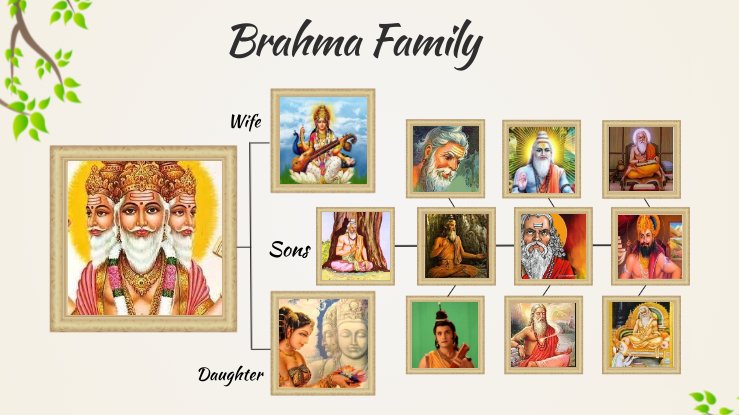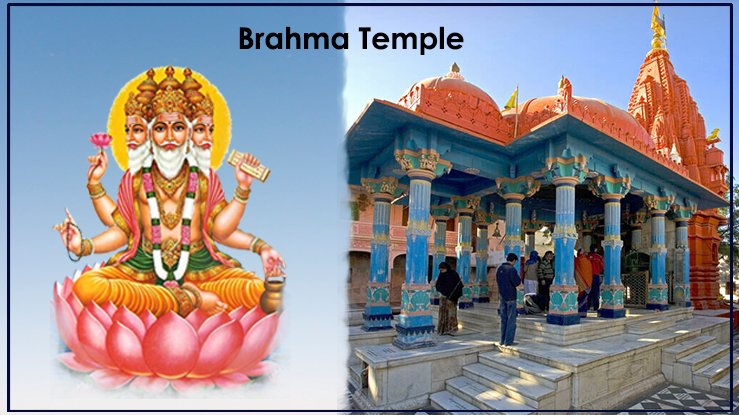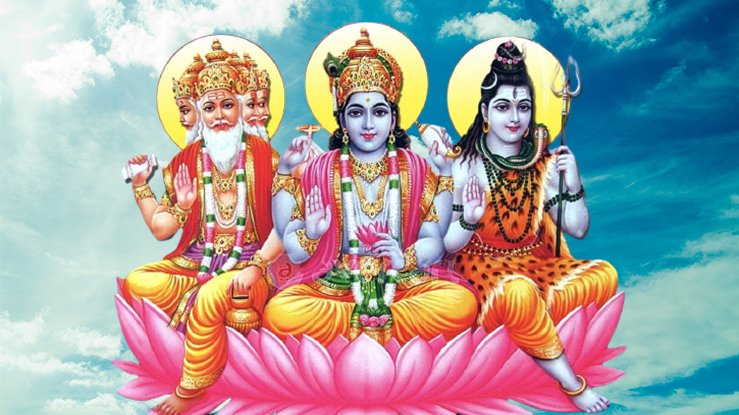Lord Brahma is known as the Creator of the Universe within the Tridev, the holy trinity of Supreme Beings, along with Lord Shiva and Lord Vishnu. He is also known as Svayambhu, which literally means ‘self-born’, and is usually associated with creation, Vedas, and knowledge.
Who is Lord Brahma?
Lord Brahma is a prominent deity in Hindu mythology who is related to the creation of the universe. He is depicted with 4 faces, 4 arms, and a long white beard. All his faces point to a cardinal direction- the East, North, West, and South. His white beard symbolizes his sagely experience and his 4 mouths created the 4 Vedas. He is usually seated on a white, red or pink lotus, with his Vahan (mount) Hans (swan).
Unlike other Gods & Goddesses, his hands hold no weapons but symbols of knowledge and creation. In one hand, he holds the sacred text of the Vedas (symbolizing knowledge of and about all beings), another holds Jaap Mala (rosary beads), in the third he holds the Shruk/ Sruva (a ladle- like utensil used to feed sacrificial fire), and in the fourth he holds a Kamandal (a utensil used to hold water, symbolizing the means where all creations emerge from).
Birth of Lord Brahma
There are numerous stories about his birth in various sects (Vaishnavism, Shaivism, Shaktism, etc.), with the most famous one being born from Shakti.
In the Brahmananda Puran, it was said that there was nothing but an eternal ocean. Later, a golden egg Hiranyagarbha emerged from the ocean and broke open. From there, he created himself within the egg and came into existence. Then, he went on to create the Universe, Earth and other beings.
In the Mahabharata and Puran(s), he is depicted as the secondary creator, being born from the navel of Lord Vishnu on a lotus. In the texts of Shaivism, Brahma is said to be created by the Ardhanarishwar (Half Parvati Half Shiva), or by Rudra (a form of Shiva).
In Shaktism, the story of Lord Brahma is shown as being born of Adi Para Shakti, and is assigned to be the creator while Shiva and Vishnu, after being born, were assigned to be the Destroyer and the Preserver respectively. Brahma is said to be acting on behalf of Shakti, creating all forms while the Universe was created by Shakti herself.
Who Created Lord Brahma?
Shakti, also known as Adi Para Shakti is one of the foremost Supreme Beings credited with the creation of Lord Brahma. Lord Shiva and Lord Vishnu are said to be his creators in other spiritual texts and ancient scriptures.
What are the Different Names of Lord Brahma?
There are many names of Brahma in different ancient spiritual texts and Vedic scriptures. Here are some of them with their meanings.
- Brahma- Supreme, Creator, the life breath of all things living.
- Atmabhu/ Svayambhu- Self existent, the one who created himself.
- Surajyesth- Elder of all deities.
- Parameshti- One who gives the supreme desire (Moksh), one who stays in the heart of the lotus, one worshipped with Yagya (ishti).
- Pitamah- Grandfather.
- Abjayonih/ Kamalodbhava- One who is lotus born.
- Kamalasana- One who is seated on a lotus.
- Viswasrush- One who hears everything.
- Hansavahan- One who has swan as their mount.
- Virinchi- Creator
- Vedanath- God of Vedas
- Chaturmukha/ Chaturnana- One having Four Faces
- Gyaneshwar- God of Knowledge
Lord Brahma Family

Lord Brahma has a wife/ consort, Goddess Saraswati– the Hindu goddess of knowledge, art, music, wisdom, speech, and learning. She is depicted as having golden skin, dressed in pure white, holding a Veena in her hands, and seated on a fully bloomed lotus. She has a swan and a peacock as her mounts. She is usually depicted with 4 hands- holding a rosary, a book, and a Kamandal along with the Veena.
Brahma created his offspring from his mind- 10 sons (also known as Prajapatis) and a daughter. Since he created them from his mind rather than the body, the Prajapatis were known as Manas Putras (Mind- sons). The sons were known as
- Marichi Rishi
- Atri Rishi
- Angirasa Rishi
- Pulaha Rishi
- Pulutsya Rishi
- Krathu Rishi
- Vashisth
- Prachethasa
- Bhrigu
- Narad Muni
The daughter was known as Shatarupa.
Why Lord Brahma is not Worshipped?
There are a few legends which resulted to Lord Brahma not being worshipped as much as Lord Vishnu and Lord Shiva- with 1st related to Shatarupa, 2nd related to his ego about superiority over Shiva, and the 3rd due to Bhrigu’s curse.
The 1st legend says that in the beginning, Brahma only had one head. After Brahma created Shatarupa (the female with 100 beautiful forms), he became infatuated with her beauty and stared at her everywhere she went. To do so, he even grew heads to face the 4 directions. To escape his gaze, Shatarupa tried jumping over his head, but Brahma grew a head on top of the others. Enraged at his misconduct, Shiva appeared and cut off his 5th head to put an end to Shatarupa’s misery and said that since even after being a Supreme god, his conduct was unholy so no living being would worship Brahma as a consequence. Since then, Brahma has been reciting the 4 Vedas from his 4 mouths in repentance.
The 2nd legend starts with the debate of Brahma and Vishnu about who is superior among the Tridev. Since the argument between the two went on for quite some time, Shiva intervened and let out a never-ending beam of light that pierced all the realms of the Universe. Then, he asked both Brahma and Vishnu to find out the end of the pillar of light. Brahma took the form of a swan and flew upwards to find it and Vishnu took the Avatar (form) of a boar and began digging downwards. Even after trying hard, they couldn’t find it, so Vishnu returned and admitted his defeat to Shiva. Brahma, on the other hand, couldn’t bear to lose and lied that he found the end of the light. Shiva, who knew that Brahma was lying, was driven to anger and cut off Brahma’s 5th head; cursing him that no living being in all 3 worlds would worship him.
In the 3rd legend, Bhrigu Rishi was going to conduct a great fire sacrifice on Earth. It was the prevailing decision that the supreme of all beings would preside over the ceremony. Bhrigu set off to invite the Tridev (Shiva, Vishnu, and Brahma) and successfully invited both Shiva and Vishnu. However, Brahma was so immersed in Saraswati’s musical skills that no matter how many times or how loud Bhrigu called, Brahma couldn’t hear him. Bhrigu cursed God in a rage that no one on Earth would ever invoke or worship him.
Why there is only one Temple of Lord Brahma?

Since the curse(s) placed upon the Lord, people began forgetting about him and as a consequence, most temples of Brahma were destroyed or left in ruins. The only Brahma temple left was at Pushkar Lake, Rajasthan. This temple too, has faced innumerable ravages of time but it was partly rebuilt again later.
How to Worship Lord Brahma?
Lord Brahma is worshipped with a particular count (generally 1,25,000) of the Brahma mantras, which please the Lord Brahma and blesses the devotees with good fortune. After this is done, Sankalp is performed with the help of a pandit. In online puja booking services of Online Temple, the chanting of the Brahma mantra is done on behalf of the devotee, keeping the devotee’s name in mind.
The Sankalp is performed after the chant is over, which usually takes around 7 days. Online Temple sends a list of dos & don’ts for the devotees to follow so that they can get the optimum benefits of the puja. After the devotee has completed all of the instructions provided, a Sankalp ceremony takes place via Zoom.
The conclusion ceremony comes after this, post which Online Temple recommends doing a Havan to appease the deity. In the Havan, the experienced and skilled pandits of Online Temple mention that the devotee s unable to attend the puja in person and that the puja is being performed on their behalf. The devotees’ names and other details are mentioned so that the puja & Havan can shower the devotees and their close ones with divine blessings, no matter where they are in the world.
A few general instructions recommended by Online Temple experts are:
- Non vegetarian food is prohibited immediately before, during and after the puja till the day of the puja ends. Only vegetarian food is allowed for the devotees and anyone who is participating in the puja.
- Smoking and alcohol consumption is prohibited immediately before, during and after the puja till the day of the puja ends.
- One should think and do positive on the day the puja begins till the puja ends. This helps the devotee immerse themselves fully in the puja.
- No violence is allowed during this period.
- The devotees should wake up early, have a bath and dress in fresh clothes on the day of the puja.
Failure to comply with the above basic instructions may result in the devotee not receiving the blessings to its full potential, and if the puja is being performed as a remedy, there would not be any major breakthroughs in their situation.
Benefits of Worshipping Lord Brahma
- Achieve assured success in all endeavors and overcome all obstacles.
- Enhances concentration and hence, productivity in all walks of life.
- Attain the 4 goals of life- Wealth, Righteousness, Desire, & Liberation.
- Amplifies knowledge and learning prowess of the devotee.
- Removes all types of fear and anxieties in the mind.
- Rids of all negativity and dark energies around the devotee.

Also Read :- Why Raksha Bandhan Festival Is Celebrated?

